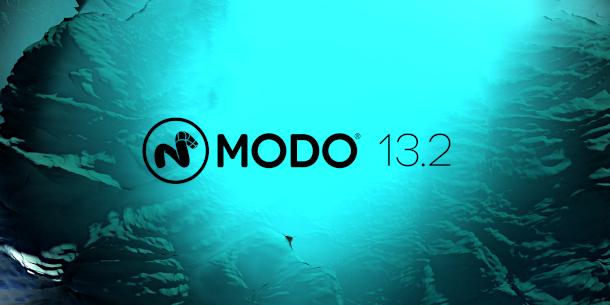Foundry ships Modo 13.2

Foundry has released Modo 13.2, the last of three linked updates to its modelling and animation software that will form this year’s Modo 13 Series.
The update adds mPath, a new path tracing renderer described as a “ground-up redesign” of the default Modo renderer, capable of making use of either the CPU or Nvidia GPUs for ray tracing.
There are also new rigging and animation tools, including a new Planar IK system, a system of Gradient Layers and Gradient Modifiers, and workflow improvements to the Graph Editor.
Other changes include an Edge Chamfer tool, intended as an ultimate replacement for Edge Bevel; and updates to the ProRender renderer and workflows using the AxF material format.
mPath: a new GPU-capable alternative to Modo’s default CPU renderer
Although Foundry had previously hinted that Modo 13.2 was going to be another performance-focused release, in the event, the update adds a lot of new features.
Chief among them is mPath, the new path tracing render engine described as a “ground-up” redesign of Modo’s ageing default renderer, which was first added to the software in 2006.
As well as supporting a wider range of hardware – it can use both the CPU and Nvidia GPUs for ray tracing – mPath promises a simpler workflow and more flexible render output than its predecessor.
Rigging: new art-directable Planar IK system
Other changes in Modo 13.2 include new rigging and animation tools, including a new Planar IK system (shown above), for rigging two- and three-locator chains, like limbs.
In a Pixel Fondue livestream, former Pixar TD Rich Hurrey, now running Modo training platform Kitestring, described the implementation as a more “art-directable” IK solver.
New controls include an Ankle Bias setting to control where a limb flexes when the end locator is moved.
“It’s the kind [of control] you need when [you’re working with animators] who are looking for key silhouettes, and it’s something that hasn’t been there in Modo [until now],” said Hurrey.
The system can also generate stretchy IK and soft IK systems, with the rigged limb easing more realistically into key poses, rather than simply snapping to its maximum extension.
Other rigging features include a new Twist Extractor node, which enables users to “extract twist (roll), yaw, and pitch from a local matrix”.
The twist output can then be used to smooth deformations: for example, on a character’s lower arm as the wrist is rotated, or the lower leg as the foot is rotated.
New gradients system creates more compact, controllable character rigs
The update also makes it possible to use gradients much more widely thoughout Modo, adding the option to modify gradient curves via a layer stack or a set of new Gradient Modifiers.
One key use case is in creating character rigs: in the Pixel Fondue stream, Hurrey contrasted the process of creating a facial rig in Modo 13.1 and 13.2.
A lip control rig created in Modo 13.1 using cascading falloffs required seven deformers per lip; the equivalent rig created using gradients in Modo 13.2 required one.
“Everything about this is better,” he commented. “It’s easier to author, it’s faster to evaluate, it’s smaller on disk, and it gives me more control.”
As well as character rigs, gradients can now be used to control a range of features throughout Modo, including procedural modelling operations and particle systems.
Animation: workflow improvements to the graph editor
Animators get a set of workflow improvements to Modo’s graph editor, including the option to fit the Timeline range to the animation channel or scene item selected, as shown above.
There are also new options to normalise sets of animation curves, which scales them all to a common vertical range, making animation channels with numerically smaller changes easier to read at a glance.
Animation channels can also now be displayed individually, arranged in a vertical stack, rather than each animation curve being superimposed on the others.
Other changes: new Edge Chamfer tool, updates to ProRender and AxF workflows
Other new features include Edge Chamfer, a new alternative to Modo’s Edge Bevel.
Like Edge Bevel, which it is ultimately intended to replace, it generates rounded edges on a mesh, but produces “better geometry and cleaner UVs”.
More significantly for most users, it also works with a wider range of mesh topologies, reducing the number of cases in which a bevel operation fails to produce usable results.
ProRender, AMD’s physically based GPU render engine, first added in Modo 13.0, and primarily used for interactive previews, gets a further update.
The renderer now supports Modo’s physical material more closely, including its Specular and Fade properties; and supports the Film Offset properties of the Modo camera.
Support for AxRite’s AxF format, intended to make it easier to exchange material data between DCC and CAD applications, has also been extended.
AxF files can now be dragged and dropped into Modo to add them to a scene; and the software “supports more texture effects for the SVBRDF material type in AxF versions 1.0, 1.1, 1.4, and 1.5”.
Pricing and availability
Modo 13.2 is available for 64-bit Windows 10, RHEL and CentOS 7+ Linux, and macOS 10.12+. New perpetual licences of the software cost $1,799, while rental starts at $599/year.
Read an overview of the new features in Modo 13.2 on Foundry’s website
Read a full list of changes in Modo 13.2 in the online release notes
Full disclosure: in my other life as a freelance technical writer, I helped Foundry produce some of the marketing material for Modo 13.2. CG Channel has no financial connection with Foundry.
